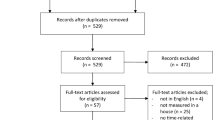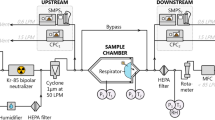Abstract
Allergens and other pollutants in house dust are collected using a variety of dust samplers that are assumed to operate similarly. This factorial design study compared sampler performance under controlled environmental conditions. House dust with known particle sizes (212–90, 90–45, and <45 μm) and allergen concentrations were sampled from new carpet squares with varying denier, pile height and pile densities. Dust mass and allergen recovery for total dust mites (Der p 1 and Der f 1), cat (Fel d 1) and cockroach allergen (Bla g 1) were assessed using the Eureka Mighty Mite (EURK), the High Volume Small Surface Sampler (HVS), or the American Industrial Hygiene Association (AIHA) method. Allergen concentrations were quantified using enzyme-linked immunosorbent assays, and dust mass results were corrected for carpet fiber shedding. Samplers were compared by exploring mass collection efficiency (CE=fiber corrected dust mass/applied dust mass) and concentration ratio (CR=allergen concentration in collected sample/allergen concentration in test dust). Test dust allergen concentrations varied by particle size fraction due to varying laboratory performance over time. The EURK and HVS samplers had CEs of 41–63% in the small and medium particle size fractions, and collected less than 20% of the available dust from the large size fraction. The AIHA CE ranged from 10% to 17% in the medium and small particle size fractions, but collected little dust in the largest particle size fraction. The AIHA and HVS samplers were more likely to acquire more representative and less variable allergen CRs compared with the EURK method. Health studies that use allergen concentration as an exposure metric need to consider the implications of sampler performance when interpreting links to health outcomes and development of health-based standards for allergens in house dust.
This is a preview of subscription content, access via your institution
Access options
Subscribe to this journal
Receive 6 print issues and online access
$259.00 per year
only $43.17 per issue
Buy this article
- Purchase on Springer Link
- Instant access to full article PDF
Prices may be subject to local taxes which are calculated during checkout
Similar content being viewed by others
Abbreviations
- AIHA:
-
American Industrial Hygiene Association (vacuum sampling method)
- Bla g 1:
-
Major allergen of the German cockroach
- CE:
-
Collection efficiency
- CR:
-
Concentration ratio
- CV:
-
Coefficient of variation (%)
- Der f 1:
-
Dermatophagoides farinae allergen
- Der p 1:
-
Dermatophagoides pteronyssinus allergen
- ELISA:
-
Enzyme-Linked ImmunoSorbent Assay
- EURK:
-
Eureka Mighty Mite
- Fel d 1:
-
Felis domesticus allergen
- HVS:
-
High volume surface sampler
- RH:
-
Relative humidity
References
Arbes SJ, Sever M, Vaughn B, Mehta J, Lynch JT, Mitchell H et al Feasibility of using subject-collected dust samples in epidemiologic and clinical studies of indoor allergens. Environ Health Perspect 2005; 113: 665–669.
Adgate JL, Ramachandran G, Cho SJ, Ryan AD, Grengs J . Allergen levels in inner city homes: baseline concentrations and evaluation of intervention effectiveness. J Expo Sci Environ Epidemiol 2008; 18: 430–440.
Krieger J, Jacobs DE, Ashley PJ, Baeder A, Chew GL, Dearborn D et al Housing interventions and control of asthma-related indoor biologic agents: a review of the evidence. J Public Health Manag Pract 2010; 16 (5 Suppl): S11–S20.
Wilson J, Dixon SL, Breysse P, Jacobs D, Adamkiewicz G, Chew GL et al Housing and allergens: a pooled analysis of nine US studies. Environ Res 2010; 110: 189–198.
IOM. Clearing the Air: asthma and indoor air exposures. National Academy Press Washington, D.C.. 2000.
Topp R, Wimmer K, Fahlbusch B, Bischof W, Richter K, Wichmann HE et al Repeated measurements of allergens and endotoxin in settled house dust over a time period of 6 years. Clinical and Experimental Allergy: Journal of the British Society for Allergy and Clinical Immunology 2003; 33: 1659–1666.
Wang E, Rhoads GG, Wainman T, Lioy PJ . Effect of environmental and carpet variables on vacuum sampler collection efficiency. Appl Occup Environ Hyg 1995; 102: 111–119.
Lewis RD, Breysse PN, Lees PS, Diener-West M, Hamilton RG, Eggleston P . Factors affecting the retention of dust mite allergen on carpet. Am Ind Hyg Assoc J 1998; 59: 606–613.
Lewis RD, Breysse PN . Carpet properties that affect the retention of cat allergen. Annals of allergy, asthma & immunology: official publication of the American College of Allergy. Asthma, & Immunology 2000; 84: 31–36.
Arlian LG . Arthropod allergens and human health. Annu Rev Entomol 2002; 47: 395–443.
Tovey ER, Chapman MD, Platts-Mills TA . Mite faeces are a major source of house dust allergens. Nature 1981; 289: 592–593.
de Blay F, Sanchez J, Hedelin G, Perez-Infante A, Verot A, Chapman M et al Dust and airborne exposure to allergens derived from cockroach (Blattella germanica) in low-cost public housing in Strasbourg (France). J Allergy Clin Immunol 1997; 99 (1 Part 1): 107–112.
Chew GL, Higgins KM, Gold DR, Muilenberg ML, Burge HA . Monthly measurements of indoor allergens and the influence of housing type in a northeastern US city. Allergy 1999; 54: 1058–1066.
Vojta PJ, Friedman W, Marker DA, Clickner R, Rogers JW, Viet SM et al First National Survey of Lead and Allergens in Housing: survey design and methods for the allergen and endotoxin components. Environ Health Perspect 2002; 110: 527–532.
Mansour M, Lanphear BP, Hornung R, Khoury J, Bernstein DI, Menrath W et al A side-by-side comparison of sampling methods for settled, indoor allergens. Environ Res 2001; 87: 37–46.
ASTM. ASTM F608-97. standard test method for evaluation of carpet-embedded dirt removal effectiveness of Household/Commercial Vacuum Cleaners. F1121. American Society for Testing and Materials International West Conshohocken, PA. 1997.
Roberts JW, Budd WT, Ruby MG, Bond AE, Lewis RG, Wiener RW et al Development and field testing of a high volume sampler for pesticides and toxics in dust. J Expo Anal Environ Epidemiol 1991; 1: 143–155.
Dillion K, Heinsohn P, Miller D (eds).. Field Guide for the Determination of Contaminants in Environmental Samples. American Industrial Hygiene Association Publications. 1996.
Ramachandran G, Adgate JL, Banerjee S, Church TR, Jones D, Fredrickson A et al Indoor air quality in two urban elementary schools—measurements of airborne fungi, carpet allergens, CO2, temperature, and relative humidity. J Occup Environ Hyg 2005; 2: 553–566.
Lewis R, Chen D . Indoor allergen surface sampling methods and standards: a review of the theory and the practice. J ASTM Int 2011; 8: 13.
Envirometrics. High Volume Small Surfaace Sampler (HVS3) Operation Manual, 204 [updated 2004; cited 2012 July 31]; Available from http://www.envirometrics.com/equip/HVS3manual.pdf.
Lewis RD, Breysse PN, Sterling DA, King B . A soiling system for evaluation of house dust, allergens, and lead retention on carpets and other surfaces. Appl Occup Environ Hyg 1999; 14: 845–851.
Chapman MD, Heymann PW, Wilkins SR, Brown MJ, Platts-Mills TA . Monoclonal immunoassays for major dust mite (Dermatophagoides) allergens, Der p 1 and Der f 1, and quantitative analysis of the allergen content of mite and house dust extracts. J Allergy Clin Immunol 1987; 80: 184–194.
Wood RA, Eggleston PA, Lind P, Ingemann L, Schartz B, Graveson S et al Antigenic analysis of household dust samples. Am Respir Dis 1988; 137: 358–363.
Custovic A, Taggart SC, Woodcock A . House dust mite and cat allergen in different indoor environments. Clinical and Experimental Allergy: Journal of the British Society for Allergy and Clinical Immunology 1994; 24: 1164–1168.
Liccardi G, Barber D, Russo M, Canonica GW, D'Amato G, Senna G et al Effectiveness of vacuum-cleaning in removing Fel d 1 allergen from cotton fabrics exposed to cats. Eur Ann Allergy Clin Immunol 2007; 39: 167–169.
Adgate JL, Clayton CA, Quackenboss JJ, Thomas KW, Whitmore RW, Pellizzari ED et al Measurement of multi-pollutant and multi-pathway exposures in a probability-based sample of children: practical strategies for effective field studies. J Expo Anal Environ Epidemiol 2000; 10 (6 Part 2): 650–661.
Sullivan SD, Weiss KB, Lynn H, Mitchell H, Kattan M, Gergen PJ et al The cost-effectiveness of an inner-city asthma intervention for children. J Allergy Clin Immunol 2002; 110: 576–581.
Needham LL, Ozkaynak H, Whyatt RM, Barr DB, Wang RY, Naeher L et al Exposure assessment in the National Children's Study: introduction. Environ Health Perspect 2005; 113: 1076–1082.
HUD. Vacuum Dust Sample Collection Protocol for Allergens. HUD Office of Health Homes and Lead Hazard Control. 2008.
Colt JS . Comparison of pesticides and other compounds in carpet dust samples collected from used vacuum cleaner bags and from a high-volume surface sampler. Environ Health Perspect 1998; 106: 721–724.
Colt JS, Gunier RB, Metayer C, Nishioka MG, Bell EM, Reynolds P et al Household vacuum cleaners vs. the high-volume surface sampler for collection of carpet dust samples in epidemiologic studies of children. Environ Health 2008; 7: 6.
Svendsen E, Thorne P, O'Shaughnessy P, Zimmerman D, Reynolds S . House dust collection efficiency of the high volume small surface sampler on worn carpets. J Occup Environ Hyg 2006; 3: 334–341.
Causer SM, Lewis RD, Batek JM, Ong KH . Influence of wear, pile height, and cleaning method on removal of mite allergen from carpet. J Occup Environ Hyg 2004; 1: 237–242.
Causer SM, Shorter CL, Lewis RD, Siebers RW . Efficiency of vacuuming for the removal of cat allergen (Fel d 1) from worn and unworn wool carpets of different construction. Text Res J 2008; 78: 105–110.
Adgate JL, Willis RD, Buckley TJ, Chow JC, Watson JG, Rhoads GG et al Chemical mass balance source apportionment of lead in house dust. Environ Sci Technol 1998; 32: 108–114.
Lioy PJ, Freeman NC, Millette JR . Dust: a metric for use in residential and building exposure assessment and source characterization. Environ Health Perspect 2002; 110: 969 83.
Whitehead T, Metayer C, Buffler P, Rappaport SM . Estimating exposures to indoor contaminants using residential dust. J Expo Anal Environ Epidemiol 2011; 21: 549–564.
Acknowledgements
This research was funded by the Healthy Homes Technical Study Grant MNLHH0153-06 from the Department of Housing and Urban Development (HUD). Mention of commercial services or brands does not imply endorsement by HUD or the Universities of Colorado or Minnesota.
Author information
Authors and Affiliations
Corresponding author
Ethics declarations
Competing interests
The authors declare no conflict of interest.
Rights and permissions
About this article
Cite this article
Adgate, J., Banerjee, S., Wang, M. et al. Performance of dust allergen carpet samplers in controlled laboratory studies. J Expo Sci Environ Epidemiol 23, 385–391 (2013). https://doi.org/10.1038/jes.2012.112
Received:
Accepted:
Published:
Issue Date:
DOI: https://doi.org/10.1038/jes.2012.112
Keywords
This article is cited by
-
A side-by-side comparison of three allergen sampling methods in settled house dust
Journal of Exposure Science & Environmental Epidemiology (2014)



